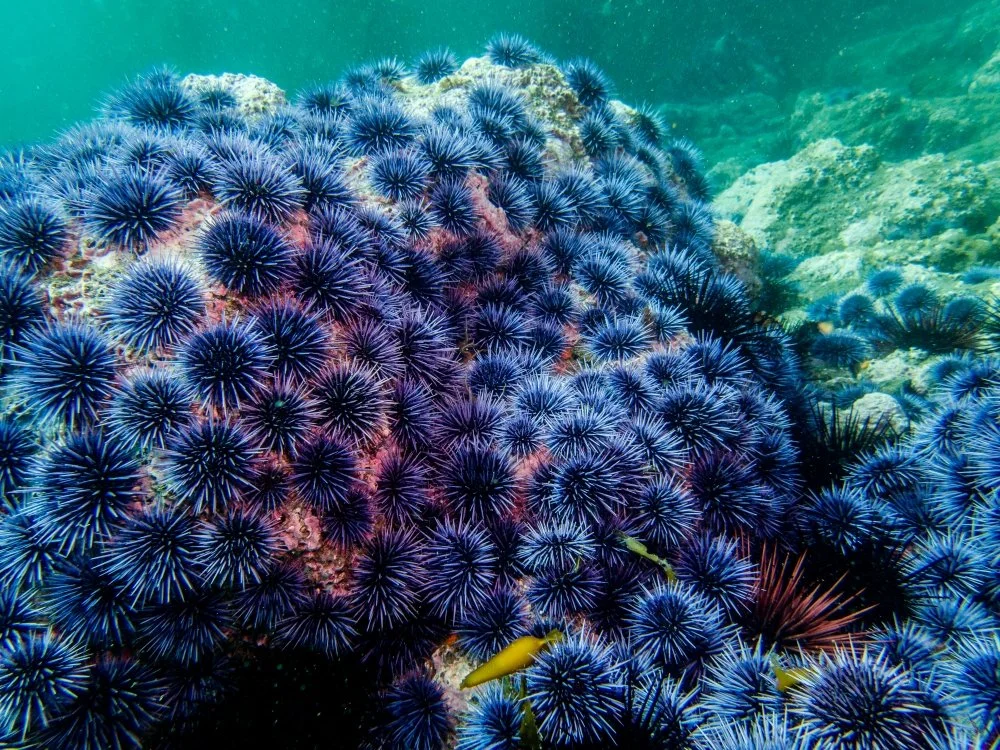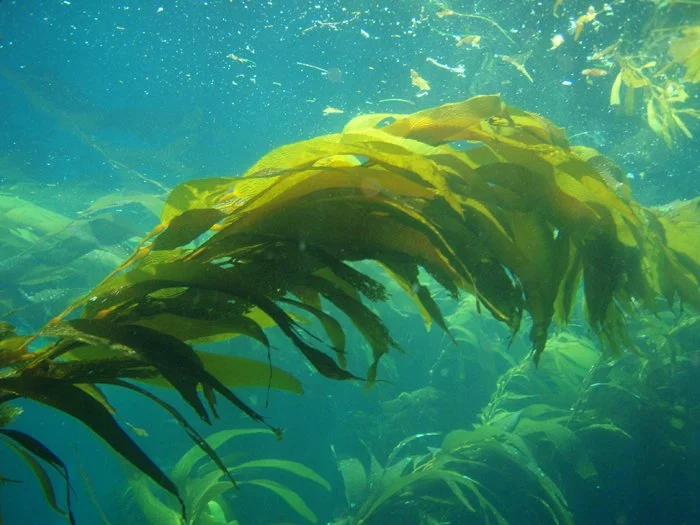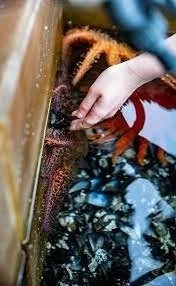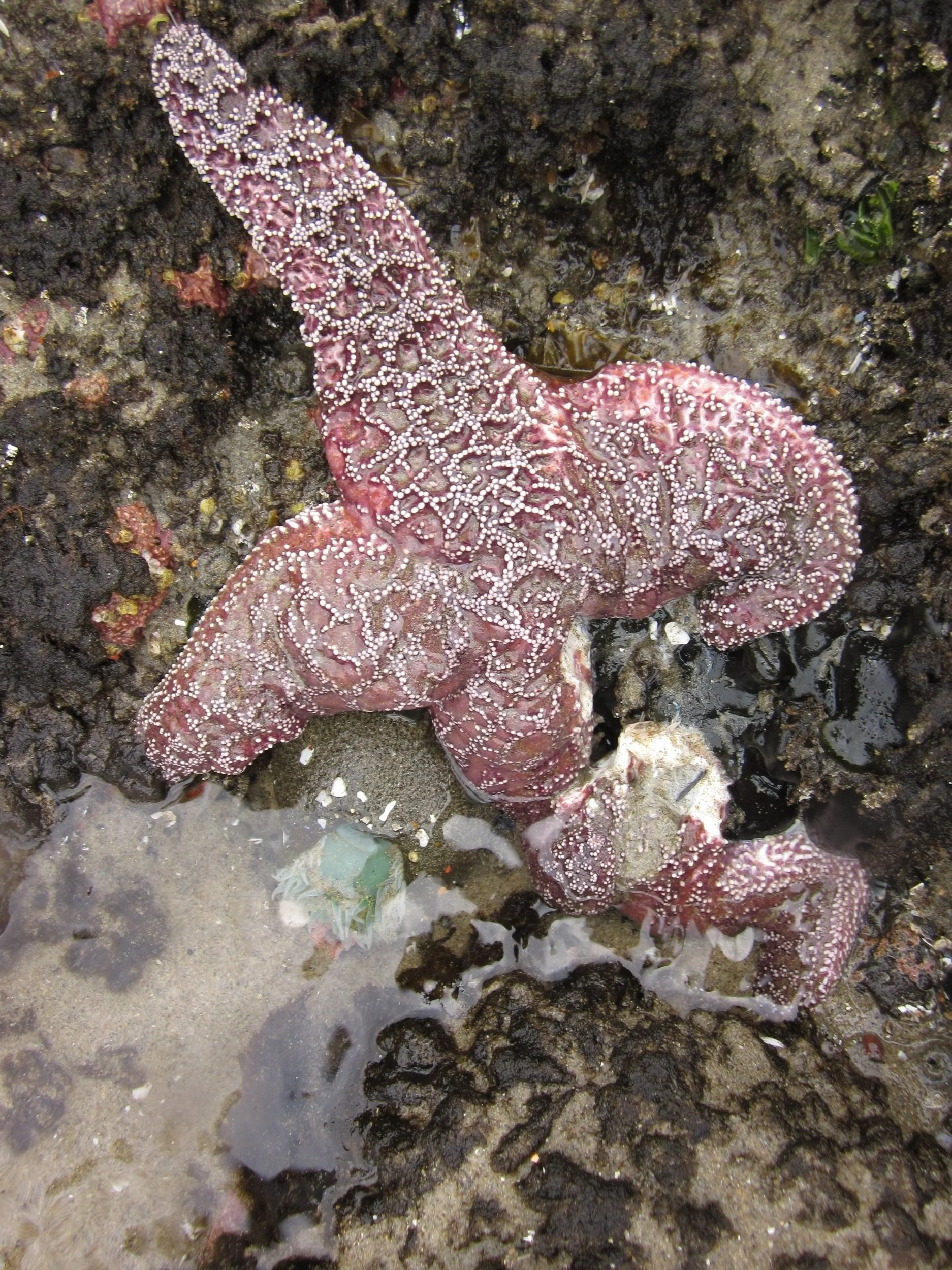Sea Star Wasting Disease
In 2014, one of the largest mass mortality events in recorded history occurred right off the Pacific coast of North America. Sea stars from Alaska to Mexico were disintegrating and dissolving into piles of goo within a matter of days. This disease occurred on a scale that was previously unheard of. (NOAA) This widespread phenomenon was named Sea Star Wasting Syndrome (SSWS). Scientists were powerless as marine ecosystems were destroyed. There were many theories about what was causes SSWS, and there still isn't a definitive answer, but many theories point to warming oceans as a major factor.
In our area, Sea Stars are a major predator of Sea Urchins. Sea Urchins eat Kelp which is vital for many other species of fish and otters. Kelp also absorbs large amounts of carbon dioxide from the atmosphere, an important factor in climate change. When the Sea Star population was suddenly diminished, the urchin population rose, and the kelp forests suffered. This in turn negatively impacted other species that depend on kelp.
Scientists were trying to figure out what was causing SSWS as it was ravaging ecosystems, but there were so many things they didn’t know. Studying marine ecosystems, their place in food chains and how they develop pushes science to keep advancing and builds public interest.
“He didn't know the answer to some of the most basic questions, such as what did this species eat early on? And how fast could it grow?
‘Nobody knows how to age a sea star, so you see something in the wild and you have no idea how old it is,’ Hodin says. ‘It could be 2 years old. It could be 50. It could be 100.’”
(NPR)
Our marine ecosystems in the pacific northwest are diverse and complex. Even seemingly small changes in water temperature or PH levels can devastate delicate ecosystems. We live in the pacific northwest, an area with amazing marine diversity, and unique ecosystems. Because there is so much we don’t know about our oceans, we don’t know all the ways they will be affected by climate change. Sea stars are major predators of Sea urchins in the pacific northwest. If Sea urchins experience a population boom in the absence of predators, they can exhaust the kelp forests which are important for many other species. For example, sea otters would have reduced shelter which would affect their population. These ecosystems are more interconnected than we know.
“Given that sea stars are important predators, the effects of such a widespread loss could be potentially devastating to sanctuary marine life in the rocky intertidal and kelp forests.
‘Any time you disrupt the food web, and in particular higher-order predators, there are usually unexpected consequences that trickle down,’ Lonhart said.”
(NOAA)
Scientists at the University of Washington are currently conducting research to find the cause of SSWS and find ways to restore our ecosystems. All the research is very experimental, they are trying to figure out how SSWS spreads, using the sea stars they bred in labs to re-release into ecosystems.
“This month, she and her colleagues are starting new lab experiments to test that idea. In a fish pathogen lab, extracts from sick sea stars will be injected into seemingly healthy ones. She'll be using sunflower sea stars since they are so susceptible.”
(NPR)
“Another problem for sea life is that increased flooding causes more nutrients to be washed into the sea. This leads to plankton blooms and ultimately causes some parts of the sea to be starved of oxygen, making it hard for fish to live there.
Warm oceans hold less oxygen, which makes the problem worse. Simpson says some areas of Japan, Taiwan and the Baltic Sea are seeing dramatic die-offs of fish because of low oxygen.”
(CNN)
This is one of the most prominent theories for the cause of SSWS. Because the water holds less oxygen, microorganisms on and around the sea stars consume the oxygen around the sea star, which leads to suffocation. It is important to be aware of the many effects climate change has on the oceans because they are some of the most vital ecosystems on the planet.
Most of the time, we focus on land ecosystems and how they will be affected by climate change, we learn about how forests capture carbon, and why we need to plant more trees. While all that information is valid, it is not the most crucial to the health of our planet. Kelp forests capture immense amounts of carbon dioxide every year, and are a much more cost effective way to combat excess carbon emissions and ocean acidification.
“An expert panel assembled by the Energy Futures Initiative estimated that kelp has the capacity to pull down about 1 billion to 10 billion tons of carbon dioxide per year.”
(Tech)
Because this is such an urgent issue, scientists don’t have much of a choice on what to do next. Even though there is a lot of research happening right now, the effects of climate change are challenging to combat. Studying the oceans now will help us prepare for major events in the future so we have more options.
"At some point we would just have to probably go forward," Harvell says, "even though scientifically that wouldn't be the very best plan."
(NPR)
Scientists haven’t found a definitive solution to SSWS, there is no known cure, but research is ongoing, and they are getting closer every day. Our Earth is rapidly changing, and the oceans are a huge factor in our ecosystems. It is only a matter of time before the consequences of their destruction catch up to us. Climate change and Global Warming are urgent issues, and the longer we let them progress, the harder they are to reverse. By learning how the world is changing and what the biggest factors are, we are empowered and informed on how to make better decisions for the planet’s future.
Sources:
https://sanctuaries.noaa.gov/news/apr14/sea-star-wasting.html
https://www.cnn.com/2019/01/12/health/warm-ocean-effects-intl/index.html
https://marine.ucsc.edu/data-products/sea-star-wasting/
https://en.wikipedia.org/wiki/Sunflower_sea_star#/media/File:Pycnopodia_helianthoides_SLO_CA.jpg
https://www.news.ucsb.edu/2020/019784/predators-spare
https://en.wikipedia.org/wiki/Sea_star_wasting_disease#/media/File:Dying_purple_ochre_sea_star.jpg
https://marine.ucsc.edu/data-products/sea-star-wasting/
https://www.eopugetsound.org/science-review/2-kelp
https://www.knkx.org/environment/2021-03-23/nw-scientist-taps-into-personalities-diets-to-help-sunflower-sea-stars-shine-again






